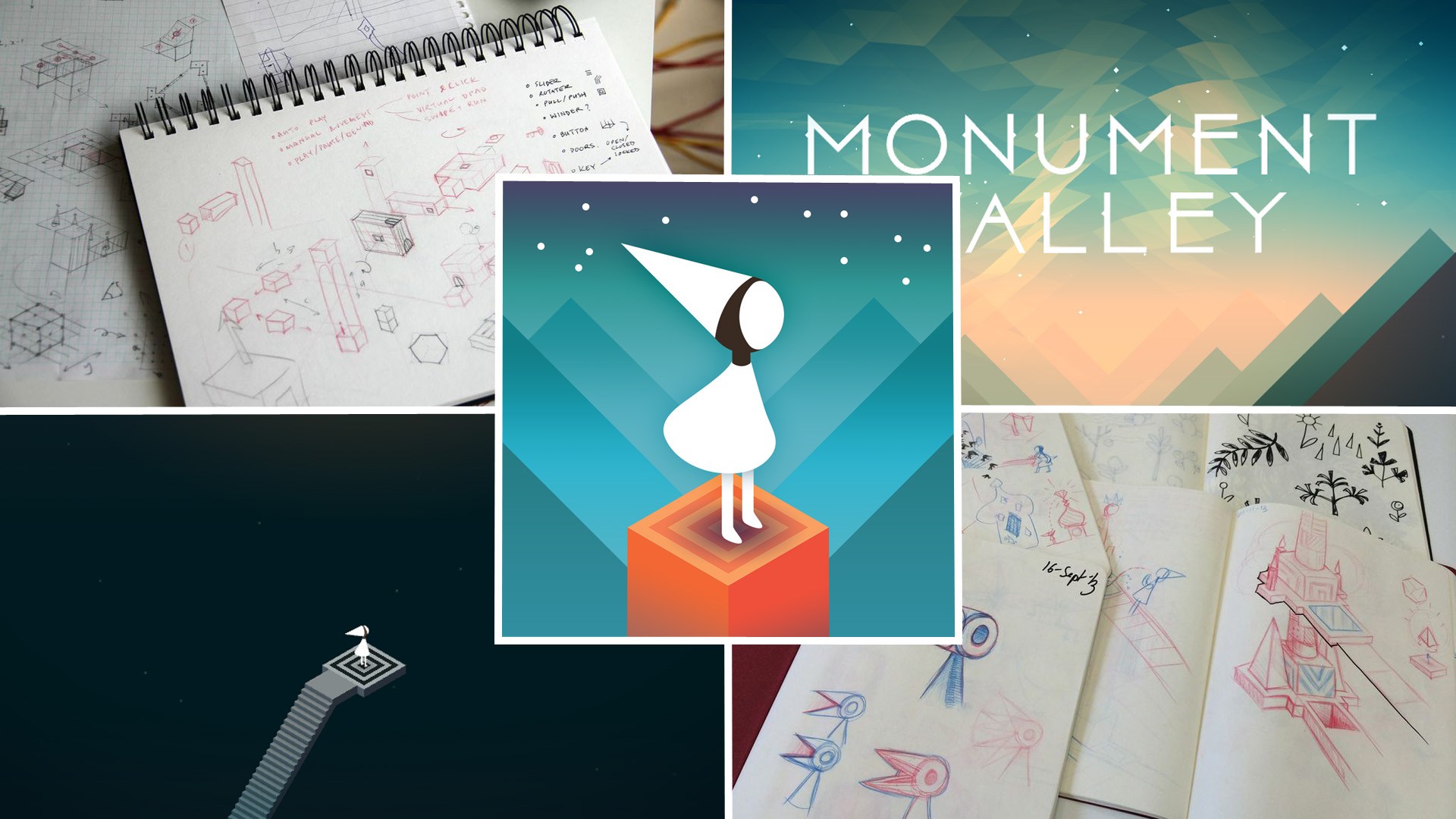ANIMAL’s feature Game Plan asks video game developers to share a bit about their process and some working images from the creation of a recent game. This week, we spoke with Ken Wong of London-based digital design firm ustwo about Monument Valley, an iOS and Android game inspired by books, music videos and M.C. Escher.
The first thing most people notice about Monument Valley is its striking and bold visual design. And that was the first thing Ken Wong, the game’s lead designer and lead artist, came up with.
Wong wanted a project where he could “make architecture the main character,” he told ANIMAL. But that vague concept only truly took shape when by chance he encountered some classic M.C. Escher art — the kind hanging in college dorm rooms everywhere. Then, Monument Valley’s first concept art — a floating building with a lone figure at the bottom — flowed from his mind to reality like a lightning strike. The art earned his team’s interest, and just like that Monument Valley was born.

In Monument Valley you play as Ida, a conical girl whose origins and motives are unclear. As the player, you manipulate the intricate monuments Ida traverses, turning levers that spin whole levels around so she can pass through black doorways that lead to the next ones. A title card informs you that Ida is on a quest for forgiveness; for what is never entirely clear. Whatever happened in the past, her only enemies now are harmless, squawking crows. Long-dead spirits guide her.
“The way that I thought about story was it would be more like a music video, where you identify the characters and you have a vague notion of their relationships and what’s happening, but it’s very much left up to interpretation,” Wong said. “Leaving things ambiguous and a bit unclear is fine. That doesn’t mean that we didn’t do our job. What matters is that we established empathy and an emotional or intellectual connection with the person who’s playing the game.”

Monument Valley is haunting and beautiful, without a trace of vulgarity or cynicism. Players swipe and tap and twist and turn the colorful worlds that Ida inhabits, like simplistic but eye-catching Rubik’s cubes. Some have complained at the lack of difficulty, but Wong wanted to make sure that anyone could experience and enjoy Monument Valley – and see it through to its end, a rare feat for many gamers these days.
“The nature of achievement and progression in games has kind of lost itself, you know?” Wong said. “All these players are collecting coins and unlocking new items and earning badges and reaching checkpoints and unlocking new characters. It’s all artificial, really. It’s not the game itself. It’s a layer on top of it.”
“In Monument, Valley Ida doesn’t collect anything,” he continued. “In fact, when she reaches the end of a monument, she gives something back.

This idea is even more poignant on smartphones and tablets, a platform on which crass free-to-play games commonly succeed by unethically preying on players’ base instincts for progression and approval. Most people waiting in line at the market or sitting in traffic don’t care that their achievements in Clash of Clans or Candy Crush are meaningless and hollow; they simply feel reassured by being told they’ve accomplished something. But Wong thinks mobile gamers deserve, and on some level even desire, better.
“A lot of people have given up [on mobile games],” he said. “We disagree with that. We think that there are ways of creating great content that will reach the kind of people that buy iPads. An iPad is a premium product. It’s a user experience product. Why shouldn’t these people be interested in great design and great storytelling?”
Ustwo is a design company, not dedicated to only video games, as Wong pointed out. His small team avoided much of the baggage that usually comes with game design, and their approach of putting visual design first “came very naturally.” They never bothered with the painstakingly detailed design documents a larger dev team would use. “We stayed organic,” Wong said. “We only planned a couple of weeks ahead because we knew that by the end of those weeks we would have a better idea of what the game was going to be and how to make it.”

“I like to think of game design as being holistic,” he continued. “Even though I pitched it as an image, that image, I think, was very suggestive about the type of gameplay it could be—that it would be sort of meditative, and it wasn’t an action game, and this wasn’t going to be about explosions and cute characters. It was going to be very understated.”
Even the game’s music was designed to not elicit specific emotions from players or manipulate them into feeling one way or another. “People are bombarded with these messages all day, as advertising has really caught on to this, and it kind of programs us,” Wong said. “There’s such power in just allowing people to engage at their own pace and their own level, in the same way that a book does. A book is so understated, and they can be so powerful, because part of it operates within their heads. Ida, the main character—she doesn’t have a face and she doesn’t have a voice. And that’s intentional.”

Monument Valley may be unique among video games, but it’s just another work of art for Wong. “My approach with my art has been to not try to make the player or the viewer feel or think anything,” he said. “My role is simply to give them stimulating material, or perhaps an alternative viewpoint, and it’s really up to them to take away whatever they feel or think. And I think that can be incredibly powerful.”



